A Jolt of Wonder,
Anticipation, and Mischief
The Cat in the Hat endpapers
A book’s endpapers quite literally hold the volume together, binding the interior pages to the cover. They also provide an exciting opportunity to set the book’s tone, to debut what’s ahead for the reader and, ultimately, to “bind” the story that rests between them. The Cat’s Debut features Dr. Seuss’s (aka Ted Geisel’s) early concept drawing for The Cat in the Hat endpapers.
The Cat is now known the world over. However, in 1957 this iconic character and his outlandish antics had never seen the light of day. Imagine a world in which the red and white stovepipe hat had never been seen. Today we all know the hat – and the face beneath it – with its warm familiarity we have come to love. At that time the world had no idea what Ted Geisel had in store for them.
The endpapers were The Cat’s coming out party. Ted spent countless hours working and reworking his Cat’s image. Over the course of a year, he created a magical personality instilled with wonder, anticipation, and mischief!
“Over the course of a year, he created a magical personality
instilled with wonder, anticipation, and mischief!”
Ted wanted to pay particular attention to how The Cat, his Cat, would be debuted to the world. These endpapers were his first opportunity to do so. We present to you…The Cat’s Debut!
The Cat’s Debut - Diptych
The Cat’s Debut - Diptych
Serigraph on Coventry Rag Paper
Image Dimensions: 25.75 inches x 35.5 inches
Limited Edition of 850 Arabic Numbers, 99 Patrons’ Collection prints, 155 Collaborators’ Proofs, 5 Hors d'Commerce, 2 Printer's Proofs
The Cat’s Debut - Left
The Cat’s Debut - Right
The Cat’s Debut - Left, Right
Serigraph on Coventry Rag Paper
Image Dimensions: 22 inches x 16 inches (each)
Limited Edition of 850 Arabic Numbers, 99 Patrons’ Collection prints, 155 Collaborators’ Proofs, 5 Hors d'Commerce, 2 Printer's Proofs
20th Century Pop Culture Would Never Be the Same
The Cat’s impact on 20th century popular culture — and these images in particular — could never have been predicted and cannot be underestimated. LIFE Books named Dr. Seuss one of the “100 People Who Changed The World,” joining the likes of Picasso, Einstein, Shakespeare, and da Vinci in that regard.
The Cat's Debut was our first introduction to the character and it propelled Dr. Seuss to this status. During a recent interview with The Art of Dr. Seuss Collection Publisher, Robert Chase, he noted:
“These may be the most important “Cat” images Dr. Seuss ever created and, as such, may be the most important works we have ever released within the canon of Seuss’s work.”
“These may be the most important “Cat” images
Dr. Seuss ever created and, as such,
may be the most important works we have ever
released within the canon of Seuss’s work.”
An Expression Speaks A Thousand Words
Expressions can be subtle, but powerful tools, in conveying our feelings and personality. At first blush, The Cat’s Debut appears to be mirror images. However, to the keen eye, there are some important differences, which help define The Cat’s legendary persona.
Looking closely, The Cat on the left has adventure swirling in his head as he begins to conceive the escapades to follow. There is a palpable anticipation in his expression. On the right, we see the aftermath of The Cat’s riotous leadership, with his more subdued countenance, knowing full well how badly things could have gone. Here, his eyes and his hands give him away.
CONCEPT DRAWINGS
Ted drew each page for every Dr. Seuss book he wrote. What many people don’t realize is that for each final-line drawing, he would create multiple concept drawings leading up to the final published image. The images would be tirelessly refined, along with the text for each page, with subtle adjustments made to characters and nuanced shifts to the writing.
In the work done for The Cat in the Hat, Ted did something rarely found in his early-stage concept drawings. Here he combines pen and ink with colored pencil, crayon, and a watercolor wash to create the background. The resulting image takes on a unique, painterly quality rarely found in the development phase of his other children’s books.


















